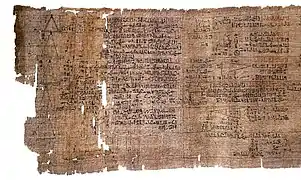Ahmes (escriba)
Ahmes (o, más exactamente, Ahmose) fue un antiguo escriba y matemático egipcio.[1] Nacido aproximadamente en el año 1660 a. C., en Egipto; y fallecido alrededor del año 1620 a. C. (40 años), en Egipto,[2] vivió durante el Segundo Periodo Intermedio y el comienzo de la dinastía XVIII (la primera dinastía del Imperio nuevo).
| Ahmes | ||
|---|---|---|
| Información personal | ||
| Nacimiento |
c. 1660 a. C. Egipto o Antiguo Egipto (Egipto) | |
| Fallecimiento |
c. 1620 a. C. Antiguo Egipto (Egipto) | |
| Información profesional | ||
| Ocupación | Escriba y matemático | |

Ahmose fue el primer contribuyente a las matemáticas cuyo nombre se conoce.[3]
Fue el copista del Papiro Rhind, así llamado por el egiptólogo escocés Alexander Henry Rhind, quien fue a Tebas por razones de salud, convirtiéndose más tarde en un aficionado a la excavación, y que compró el papiro en Egipto en 1858. Dicho papiro es un trabajo de matemáticas del antiguo Egipto que data de aproximadamente del 1650 a. C.,[4] cuyos autores originales son aún desconocidos.[5]
Ahmes no reclamó la autoría del papiro, solamente solicitó una copia. El material original procedía de un antiguo trabajo que databa del año 2000 a. C.
El papiro es nuestra primera fuente de información de la matemática egipcia. El anverso del mismo, contiene una tabla de representaciones de la división de dos por los números impares desde el tres hasta el ciento uno, en forma de suma de fracciones egipcias. A dichas fracciones se las conoce también como fracciones unidad, y consisten en quebrados cuyo numerador es la unidad. El reverso del papiro posee 87 problemas sobre las cuatro operaciones básicas, soluciones de ecuaciones, progresiones, volúmenes) de graneros, la regla de los dos tercios, etc.
El Papiro Rhind, el cual fue heredado por el Museo Británico en 1863, es denominado a veces ‘Papiro de Ahmes’ en honor a este mismo. Toda la información que poseemos de Ahmés es a través de los comentarios que realizó en el papiro.
Entre otras cuestiones, y en una época en que se desconocía la existencia de , Ahmés refiere en su escrito cómo conocer el área de un círculo de diámetro 9, mediante su equivalencia con el área de un cuadrado de lado 8. En lenguaje actual:
Ese método provee un valor de pi aproximadamente igual a 3,16049, que se halla dentro del 0,6 % del valor real de pi. Esa aproximación de «pi» como un número irracional llegaba mucho más allá del dominio de los números racionales de la matemática egipcia.
Notas y referencias
- Asimov, Isaac; Enciclopedia biográfica de ciencia y tecnología, tomo I, ISBN 84-206-0232-9 (1987).
- Fischer-Elfert (2003), 131.
- John Derbyshire (2006). Unknown quantity: a real and imaginary history of algebra. National Academies Press. p. 29. ISBN 9780309096577.
- Clifford A. Pickover (2009). The math book: from Pythagoras to the 57th dimension, 250 milestones in the History of mathematics. Sterling Publishing Company. p. 36. ISBN 9781402757969.
- Isaac Asimov (1964, 1971(trad.)). Enciclopedia biográfica de ciencia y Tecnología. Alianza Editorial. p. 2. ISBN 8420652148.
Bibliografía
- Allen, Don. Abril de 2001. The Ahmes Papyrus and Summary of Egyptian Mathematics.
- Borbola J. Kiralykörök /the Hungarian reading and solving of the Rhind-papyrus.
- Borbola J. Olvassunk együtt magyarul /Hungarian reading and solving of the Moskow Mathematic Papyrus.
- Chace, Arnold Buffum. 1927-1929. The Rhind Mathematical Papyrus: Free Translation and Commentary with Selected Photographs, Translations, Transliterations and Literal Translations. Classics in Mathematics Education 8. 2 vols. Oberlin: Mathematical.
- Clagett, Marshall. 1999. Ancient Egyptian Science: A Source Book. Volume 3: Ancient Egyptian Mathematics. Memoirs of the American Philosophical Society 232. Philadelphia: American Philosophical Society. ISBN 0-87169-232-5.
- Gardner, Milo, "An Ancient Egyptian Problem and its Innovative Arithmetic Solution", Ganita Bharati, 2006, Vol 28, Bulletin of the Indian Society for the History of Mathematics, MD Publications, New Delhi, pp. 157-173.
- Ahmes Bird Feeding Rate Method PlanetMath, 2008.
- Gillings, R., Mathematics in the Time of the Pharaohs. Boston, MA: MIT Press, pp. 202-205, 1972. ISBN 0-262-07045-6. (Out of print) Association of America. (Reprinted Reston: National Council of Teachers of Mathematics, 1979). ISBN 0-87353-133-7.
- Joseph, George G., Crest of the Peacock, Penguin Books, 1991 (pp. 71-73).
- Imhausen, A. Ägyptische Algorithmen. Eine Untersuchung zu den mittelägyptischen mathematischen Aufgabentexten, Wiesbaden 2003.
- Peet, Thomas Eric. 1923. The Rhind Mathematical Papyrus, British Museum 10057 and 10058. London: The University Press of Liverpool limited and Hodder & Stoughton limited.
- «Arithmetic in the Middle Kingdom». J. Egyptian Arch. 9, 91-95, 1923.
- O'Connor and Robertson, 2000. Mathematics in Egyptian Papyri.
- Robins, R. Gay, and Charles C. D. Shute. 1987. The Rhind Mathematical Papyrus: An Ancient Egyptian Text. London: British Museum Publications Limited. ISBN 0-7141-0944-4.
- Truman State University, Math and Computer Science Division. Mathematics and the Liberal Arts: The Rhind/Ahmes Papyrus.
- Williams, Scott W. Mathematicians of the African Diaspora, containing a page on Egyptian Mathematics Papyri.
- Weisstein, Eric W. «Rhind Papyrus». En Weisstein, Eric W, ed. MathWorld (en inglés). Wolfram Research.
Enlaces externos
- Breaking the RMP 2/n Table Code
- Math forum and two ways to calculate 2/7
- New and Old Ahmes Papyrus classifications
